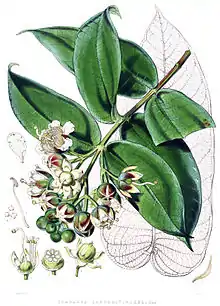Duabanga grandiflora
From its peculiar habit, Duabanga grandiflora (syn. D. sonneratioides) is a singular feature in its native forests. The trunk is erect, 40–80 feet high, undivided but sometimes forking from the base. The lower limbs spread drooping from the trunk; these are long, slender, sparingly branched, and the branches are four-angled, loosely covered with large spreading leaves. Since the leaves are arranged in two ranks, the slender branches resemble petioles, bearing pinnae of a compound leaf; the leaves are further often recurved, and are deep green above, and almost white beneath. The large blossoms expand in April, exhaling a rank odour reportedly resembling asafoetida when they first burst, but they become inodorous before the petals drop. The stamens are all bent inwards in bud. The fruit is a large as a small apple. The wood is white and soft.[2]
| Duabanga grandiflora | |
|---|---|
 | |
| Scientific classification | |
| Kingdom: | Plantae |
| Clade: | Tracheophytes |
| Clade: | Angiosperms |
| Clade: | Eudicots |
| Clade: | Rosids |
| Order: | Myrtales |
| Family: | Lythraceae |
| Genus: | Duabanga |
| Species: | D. grandiflora |
| Binomial name | |
| Duabanga grandiflora | |
Distribution
Native to India, Nepal, southern China, Myanmar and Malaysia.[3]
Gallery

 Middle story at Jayanti
Middle story at Jayanti At Jayanti
At Jayanti Leaves at Jayanti
Leaves at Jayanti
References
- Botanic Gardens Conservation International (BGCI) & IUCN SSC Global Tree Specialist Group (2019). "Duabanga grandiflora". IUCN Red List of Threatened Species. 2019: e.T61776714A145823330. Retrieved 23 January 2023.
- Hooker p.56
- "Duabanga grandiflora in Annotated Checklist of the Flowering Plants of Nepal @ efloras.org". www.efloras.org. Retrieved 2019-05-09.
- Hooker, Joseph Dalton; J. F. Cathcart; W. H. Fitch (1855). Illustrations of Himalayan plants. London: L. Reeve. pp. 55–56. LCC QK349.33 .H66 1855.
